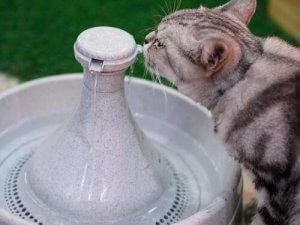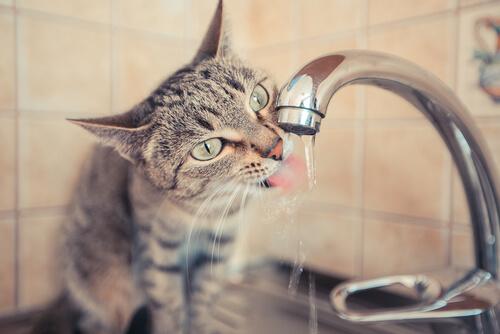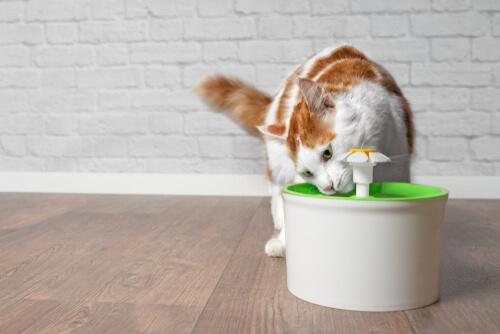How Do Cat Water Fountains Work?

Many of you know that cats love to drink moving water. And that’s why veterinarians recommend cat water fountains to make sure they’re drinking enough. It’s more natural for them because, in general, moving water is safer.
Stagnant water is a host for innumerable lethal bacteria. That’s why cats are naturally attracted to moving water and, in almost all cases, will drink more water if it’s ‘running water.’
Why are cat water fountains so important?
To put it simply, drinking enough water is vital for your pet’s health, and cat water fountains almost guarantee that your cat will drink more water.
Most people don’t think of water as a nutrient, but all of the nutrients a cat ingests require water to help them work the way they’re supposed to. Therefore, in a very real sense, a cat’s water intake is the basis of their nutrition.
Water also transports oxygen through the bloodstream and cells. As well as that, it hydrates the lungs, regulates body temperature, and helps eliminate waste products through the kidneys and the gastrointestinal tract.
Cats’ water intake—when it’s sufficient— helps the feline to have elastic-like skin and a shiny coat. These are both signs of good health.

Cats are more attracted to water in motion
Sometimes it may seem like cats are never thirsty. This may be due to the fact that they originally came from a desert environment. Most of the time, they come from areas with unattractive water sources, and their only option is standing water.
When cats are given wet food, they won’t need as much actual water. However, it doesn’t completely make up for their needed water intake. They will still need a source of water to drink from, in order to supply the vital amount of fluids they need. If your cat mainly eats dry food, water is even more important.
Learn more about cats’ water needs
Cats are prone to several different kidney and urinary tract diseases, and these are the result of insufficient water intake. One of the most serious diseases that cats, and other pets, are subject to is called urethral obstruction.
Many cats are prone to obstruction in their urethra, the tube that carries urine from the bladder. This can lead to a very serious condition, and can sometimes even lead to death.
If you don’t provide them with enough water, or there aren’t any attractive water sources, then your cat may not drink enough. This leads to their urine becoming very concentrated and, from there, the complications will start. However, enough water intake can prevent it, and that’s the main role a cat water fountain plays.
Components and operation
Electric pump
Every cat water fountain will have an electric pump. This element generates the constant movement of the water and is responsible for keeping the water fresher for longer, since it helps with oxygenation.

Filter
These are usually made with activated carbon, used both for public and domestic purification. This is responsible for filtering any impurities that are in the water. For example, hair, traces of dust or organic matter that has come in contact with the water.
Diffusers
Each fountain has a different mechanism, which allows us to choose the way we want the water to come out. You can choose different settings like trickle, waterfall, gurgling, etc. That will depend on what your cat likes best.
Types
- Plastic: The pump is silent, but the noise of the water hitting the base makes a cheap plastic sound. Cleaning is difficult and, since it’s made with plastic, it can harbor bacteria. However, they do last for a long time.
- Stainless steel: This is a reasonable option. They’re relatively easy to clean, they won’t scratch and they won’t harbor bacteria.
- Ceramic: This one makes a kind of water slide that fills the bowl. It’s one of the most attractive options on the market. The only possible negative aspect is that when they’re made in China, there’s no way to tell if they’re lead-based or enamel-based.
Many of you know that cats love to drink moving water. And that’s why veterinarians recommend cat water fountains to make sure they’re drinking enough. It’s more natural for them because, in general, moving water is safer.
Stagnant water is a host for innumerable lethal bacteria. That’s why cats are naturally attracted to moving water and, in almost all cases, will drink more water if it’s ‘running water.’
Why are cat water fountains so important?
To put it simply, drinking enough water is vital for your pet’s health, and cat water fountains almost guarantee that your cat will drink more water.
Most people don’t think of water as a nutrient, but all of the nutrients a cat ingests require water to help them work the way they’re supposed to. Therefore, in a very real sense, a cat’s water intake is the basis of their nutrition.
Water also transports oxygen through the bloodstream and cells. As well as that, it hydrates the lungs, regulates body temperature, and helps eliminate waste products through the kidneys and the gastrointestinal tract.
Cats’ water intake—when it’s sufficient— helps the feline to have elastic-like skin and a shiny coat. These are both signs of good health.

Cats are more attracted to water in motion
Sometimes it may seem like cats are never thirsty. This may be due to the fact that they originally came from a desert environment. Most of the time, they come from areas with unattractive water sources, and their only option is standing water.
When cats are given wet food, they won’t need as much actual water. However, it doesn’t completely make up for their needed water intake. They will still need a source of water to drink from, in order to supply the vital amount of fluids they need. If your cat mainly eats dry food, water is even more important.
Learn more about cats’ water needs
Cats are prone to several different kidney and urinary tract diseases, and these are the result of insufficient water intake. One of the most serious diseases that cats, and other pets, are subject to is called urethral obstruction.
Many cats are prone to obstruction in their urethra, the tube that carries urine from the bladder. This can lead to a very serious condition, and can sometimes even lead to death.
If you don’t provide them with enough water, or there aren’t any attractive water sources, then your cat may not drink enough. This leads to their urine becoming very concentrated and, from there, the complications will start. However, enough water intake can prevent it, and that’s the main role a cat water fountain plays.
Components and operation
Electric pump
Every cat water fountain will have an electric pump. This element generates the constant movement of the water and is responsible for keeping the water fresher for longer, since it helps with oxygenation.

Filter
These are usually made with activated carbon, used both for public and domestic purification. This is responsible for filtering any impurities that are in the water. For example, hair, traces of dust or organic matter that has come in contact with the water.
Diffusers
Each fountain has a different mechanism, which allows us to choose the way we want the water to come out. You can choose different settings like trickle, waterfall, gurgling, etc. That will depend on what your cat likes best.
Types
- Plastic: The pump is silent, but the noise of the water hitting the base makes a cheap plastic sound. Cleaning is difficult and, since it’s made with plastic, it can harbor bacteria. However, they do last for a long time.
- Stainless steel: This is a reasonable option. They’re relatively easy to clean, they won’t scratch and they won’t harbor bacteria.
- Ceramic: This one makes a kind of water slide that fills the bowl. It’s one of the most attractive options on the market. The only possible negative aspect is that when they’re made in China, there’s no way to tell if they’re lead-based or enamel-based.
All cited sources were thoroughly reviewed by our team to ensure their quality, reliability, currency, and validity. The bibliography of this article was considered reliable and of academic or scientific accuracy.
https://www.cathealth.com/cat-care/nutrition/2376-should-you-get-your-cat-a-water-fountain
This text is provided for informational purposes only and does not replace consultation with a professional. If in doubt, consult your specialist.








